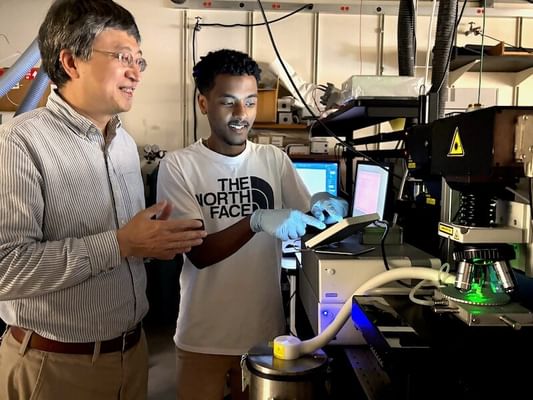- Undergraduate
Bachelor's Degrees
Bachelor of ArtsBachelor of EngineeringDual-Degree ProgramUndergraduate AdmissionsUndergraduate Experience
- Graduate
Graduate Experience
- Research
- Entrepreneurship
- Community
- About
-
Search
All Thayer News


Dartmouth Engineering Team Discovers New High-Performance Solar Cell Material
Mar 11, 2024 | by Catha Mayor
A Dartmouth Engineering-led study published in Joule presents the discovery of an entirely new high-performance material for solar absorbers—the central part of a solar cell that turns light into electricity—that is both stable and earth-abundant. The researchers used a unique high-throughput computational screening method to accelerate the discovery process and were able to quickly evaluate approximately 40,000 known candidate materials.

Professor Jifeng Liu and engineering PhD candidate Gideon Kassa conducted experimental follow-up testing to confirm the properties and potential of Zintl-phosphide BaCd2P2. (Photo by Catha Mayor)
"This is the first example in the field of photovoltaics where a new material has been found through this type of approach with an experimental follow-up," says Dartmouth's Hodgson Family Associate Professor of Engineering Geoffroy Hautier. "Most people study one or two materials at a time, and we looked at forty-thousand."
Dartmouth researcher Zhenkun Yuan is first author on the study with co-authors including research associate Yihuang Xiong, engineering PhD candidates Gideon Kassa and Andrew Pike, and engineering professors Hautier and Jifeng Liu—as well as researchers from eight other partner institutions.
The solar absorber material was confirmed in the lab to be not only promising in its ability to efficiently transform light into electricity, but also highly stable in both air and water. "You can put it out for six months and it will stay the same," notes Hautier. "When you don't have to worry about moisture and air contamination, that significantly reduces your costs."
The study points out that, normally, finding new solar materials is tedious and slow with an overwhelming number of options to even begin to consider.
"We've been building a database of known materials—both naturally-occurring and man-made—for a long time," explains Hautier, "and that's giving us the capability to rapidly screen and make decisions on what may or may not be useful. We weren't able to screen for stability, but we could narrow it down to approximately twenty reasonable solar materials—among the thousands and thousands of possibilities—and after talking with our colleagues, we had a feeling this one would be stable."

Dartmouth co-authors (l to r) Andrew Pike, Zhenkun Yuan (first author), Jifeng Liu, Geoffroy Hautier, and Gideon Kassa. (Photo by Catha Mayor)
The team plans to continue to improve the tools for even better screening, and also explore the entire family of materials they call "Zintls," which could lead to enhancements and optimizations of the discovered material.
"There are a lot of opportunities around further characterizing this material and understanding it better such as how it absorbs light and how to make it as a thin film," says Liu who conducts and oversees materials testing in his lab at Dartmouth. "Collaboration is crucial. It takes a whole community of thinkers and many different skills to make it all work—computing, experimentation, fabrication, characterization, optimization—and you need to put all that together in a team."
"We won't have it as a solar panel tomorrow," adds Hautier, "but we think this family of materials is exceptional and worth looking at."
This research is part of a US Department of Energy (DOE)-funded effort to discover new photovoltaic materials. In 2022, Hautier and Liu received a portion of the more than $540 million in awards from DOE for university- and National Laboratory-led research into clean energy technologies.
For contacts and other media information visit our Media Resources page.
